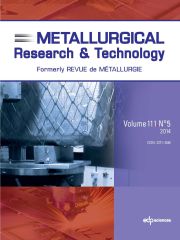Article contents
Investigation of (BOF) Converter slag use for agriculture in europe
Published online by Cambridge University Press: 16 May 2014
Abstract
The goal of zero-waste is one of the main challenges of modern steel industry, which over the past 20 years has been committed to increase the recovery and the use of by-products generated during the ironmaking and steelmaking processes. Among the main by-products generated during iron and steel production, such as slags, dusts and sludges, slags constitute about 90% of the total. Slags are currently used in various fields (such as cement production, road construction, environmental recovery in landfill covers, as fertilizer and soil conditioner, etc.) according to their chemical features, which depend on production process origin. In Italy, in particular for example, BF (Blast Furnace) slag is used for cement production while BOF (Basic Oxygen Furnace) slag without iron (inert slag) is used as landfill cover, in compliance with Italian legislation. In Germany, BF and BOF slag use as fertlisers and liming materials has a long tradition. Although in recent years slag use has increased, the application for agriculture purposes needs to be further investigated. Slag can be used as a soil conditioner (high content of Ca and Mg), Si supply (improves the crops resistance to pests and diseases), P fertilizer production and micro-nutrients supply. Use of slags can affect human health and environment, because of heavy metal content, which can leache to groundwater or be transferred to surface water. The assessment of risk to the environment based on slag application requires further investigation. This represents an opportunity for both the steel and fertilizer industries to promote natural resources savings, CO2 emission reductions, landfill waste prevention as well as social awareness of sustainability of some industrial activities. The BOF slag has been shown to be useful as liming material for acidic soil amendment and it can replace commercial fertilizers. Different effects on crop yields and on soil parameters can be found, depending on soil characteristics and climate conditions. In Middle Europe, with humid climate, lime losses through leaching of up to 0.5 t CaO/ha have to be replaced with liming material to prevent acidification. Evaluation of long-term field trials with slag liming materials can give information about the impact of slag applications on crop management and the environment. In Mediterranean regions, such as in Italy, arable soils rarely show acidic characteristics. Alkaline soils from coastal areas are often rich in sodium content, due to seawater intrusion and irrigation with saline water. The aim of this research is also to investigate the application of BOF slag to these soils, in order to assess the effect of Ca contained in slag in balancing negative Na effects. This paper is based on the preliminary study and experiments carried out within an ongoing RFCS (Research Fund for Coal and Steel) project.
- Type
- Research Article
- Information
- Metallurgical Research & Technology , Volume 111 , Issue 3: Social Value of Materials (SAM 7) , 2014 , pp. 155 - 167
- Copyright
- © EDP Sciences 2014
References
- 38
- Cited by


